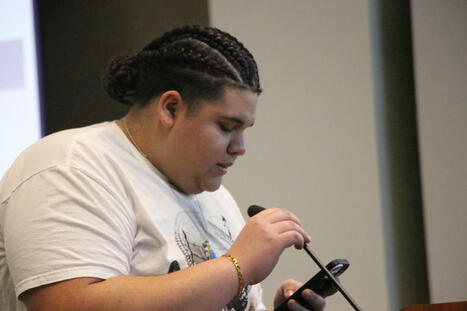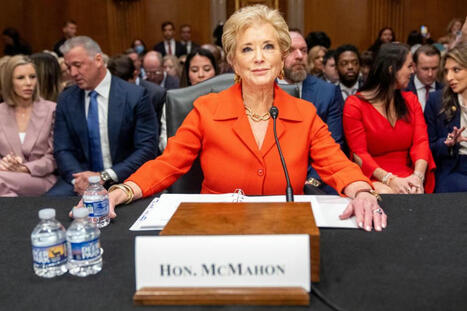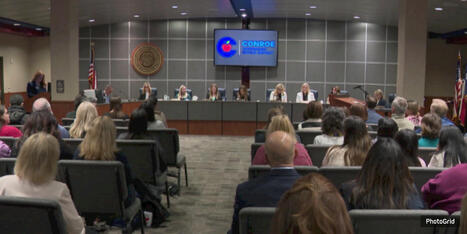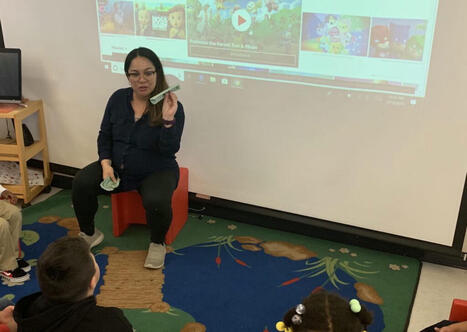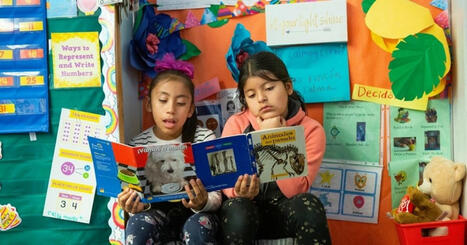 Your new post is loading...
Last month, Congresswoman Julia Brownley (D-California) announced the reintroduction of the Biliteracy Education Seal and Teaching (BEST) Act, a bill that establishes a federal grant program at the US Department of Education to recognize high-level student proficiency in speaking, reading, and writing in both English and a second language. Under this program, states would be able to establish or improve their own Biliteracy Seal programs to award seals to K–12 students. The bill focuses on supporting the implementation and scaling of Seal of Biliteracy programs and ensuring that cost is not a barrier to students participating in them. This recognition
During his freshman year, Union High School student Caiden Mizrahi-Boyarsky, a native English speaker, asked his Spanish-speaking family members to help him learn that language, too. By his sophomore
Amid the chorus of tiny voices asking endless curious questions, the warm atmosphere is immediately clear—this is a place where kids thrive and educators love what they do…
Olivia Minjares occasionally works the front of house at El Bukanas, a taquería at the corner of S. Azusa and E. Gladstone in Azusa, California. But she
Without the Education Department, advocates worry the federal government would not look out in the same way for poor students, those still learning English, disabled students and more.
Lesson planning is a political act. As previously stated in the Language Magazine article “Content, Language, and Culture Targets” (Medina, 2023), schools in the US, at the core, are designed to promote a monocultural and monolingual perspective of teaching and learning. As educators, the lessons we design and facilitate either support or dismantle educational systems that have historically marginalized certain student communities (Medina and Izquierdo, 2021). Black, Indigenous, students of color (BISoCs), language learners, children with specific academic, behavioral and/or physical health needs, and students belonging to the LGBTQ2S+ community, among others, have been deprioritized in a schooling system that
Conroe ISD Superintendent Dr. Curtis Null unexpectedly withdrew a proposal to end the district’s dual language program after a wave of public backlash. Parents and educators criticized the lack of transparency, with many only learning about the decision two days before the board meeting.
In New York and other cities across the nation, educators are grappling with fear among students and parents that US Immigration and Customs Enforcement agents will show up at schools – or their homes – as the Trump administration vows to deport millions of undocumented immigrants.
You know it when you see it” is an axiom that has been applied to rigorous educational experiences. And there is truth to this sentiment. When the classroom is humming along and teachers and students have high expectations for learning, combined with the support to achieve greatness, rigor seems self-evident. It’s obvious that learning will occur when rigor is present and that students’ content and language development will be accelerated. Yet the issue of rigor is especially problematic when it comes to multilingual learners (MLs). Evidence suggests that teachers lower the rigor threshold for these students, a process some researchers
Teachers who learned English as a second language have valuable cultural insights and experiences that can help them connect with students.
Language immersion programs not only boost academic performance but also foster cultural awareness and problem-solving abilities.

|
Scooped by
Dual Language Education of New Mexico
December 23, 2024 12:02 PM
|
All 50 states now allow students to earn a distinction on their diploma signaling their mastery of multiple languages.

|
Scooped by
Dual Language Education of New Mexico
December 23, 2024 12:00 PM
|
New students arriving in the US are usually called newcomers in a school setting. The term ‘newcomers’ is defined as K-12 students born outside the United States who arrived in the country in the last three years and are still learning English.
|
The Trump administration is requiring K–12 schools to certify that they are following federal civil rights laws and ending any discriminatory diversity, equity, and inclusion practices, as a condition for receiving federal money. A notice sent by the Education Department gives states and schools ten days to sign and return the certification. It’s the latest escalation against DEI policies, apparently giving the Republican administration a new lever for terminating federal money. The US Department of Education sent letters to state commissioners overseeing K–12 state education agencies (SEAs) requiring them to certify their compliance with their anti-discrimination obligations in order to
At the end of last month, Representatives Jen Kiggans (R-Virginia) and Jimmy Panetta (D-California) formally reintroduced the World Language Education Assistance Program (World LEAP) Act (HR 1572), which would establish a grant program through the Department of Education to create new and support current world language programs for local K–12 education for up to three years. “As someone who taught English in Japan after graduating college, I have a great appreciation for the critical role language education plays in the lives of countless Americans and our friends across the globe,” said Congresswoman Kiggans. “By giving K–12 schools the opportunity to improve and expand their world language programs, we
Texas enrolls nearly 40% of its English learners — twice the rate California does — in some form of best-in-class bilingual education.
It has been five years since that fateful moment in March 2020 when the world as we knew it changed. Three years later, the federal government declared
The Trump Education Department says changes to the Office for English Language Acquisition will not affect funding or federal programs for students. But experts and others worry that the quality of their education and training for their teachers could suffer.
In the future, bilingualism will no longer be just an advantage but a necessity. Language proficiency will extend beyond basic communication. What skills will todays children require to thrive in an ever-evolving world? Shrewsbury International
Local libraries are very instrumental in the education and assimilation process for the English learners in their community. Being hub
Integrating AI tools responsibly with storytelling empowers ELLs to find their voice and share their unique stories with confidence.
Finding ways to incorporate a student’s home language into lessons can also improve their sense of belonging and acceptance.
Walk into any classroom in the US, you’ll likely encounter students who speak a language other than English at home, who might have learned to read in another language before coming to school, or who are learning to read in more than one language in their classroom. Regardless of the language of the teacher, multilingual learners, including 10% students who are categorized as English Learners (Center for Educational Statistics, 2024) come to school every day and bring with them their valuable multilingual experiences and assets. In 2020, the NEA predicted that by 2025, one in four students in American classrooms
A new certificate program offered by the Gevirtz Graduate School of Education aims to increase the number of bilingual and culturally responsive K-12 school psychologists

|
Scooped by
Dual Language Education of New Mexico
December 23, 2024 12:01 PM
|
Bilingualism is a strength Texas is failing to nurture for hundreds of thousands of students EXPLAINERS : Dec. 16, 2024 EDUCATION Nearly one-fourth of all students in Texas public schools are emergent bilingual, meaning their home language is something other than English.
|




 Your new post is loading...
Your new post is loading...


